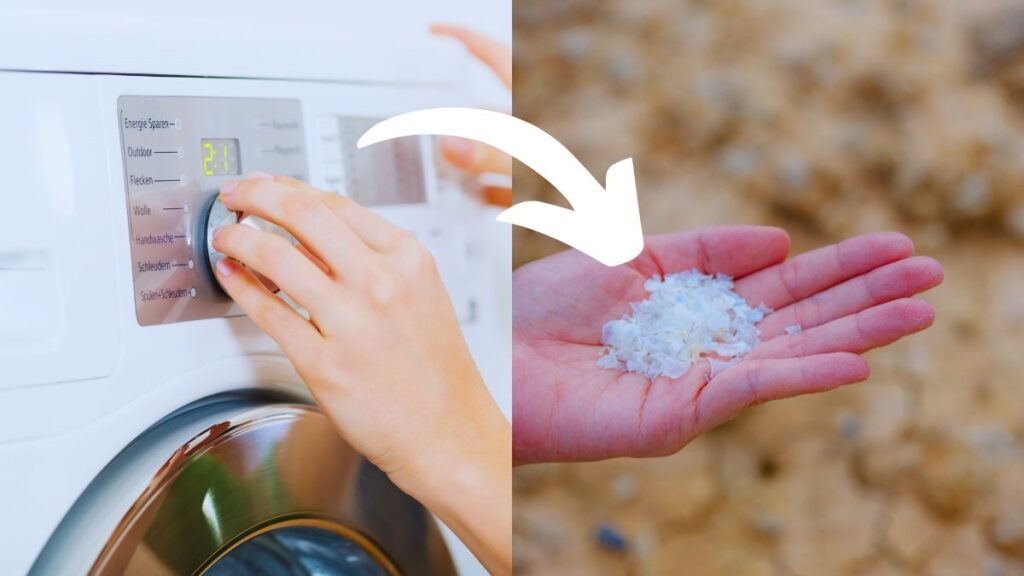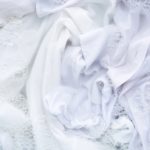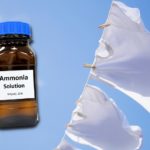Microplastics have become pervasive pollutants, infiltrating our oceans, rivers, and even human bodies.
Microplastics are plastic particles that measure no more than 5 mm in length, making them no bigger than a grain of rice. They can last hundreds of years before breaking down, and have been found all over the world, even in the most remote places.
Laundry is one of the biggest sources of microplastics in our waterways, due to plastic-containing microfibres shedding from clothes made of synthetic, plastic-based materials such as acrylic and polyester. Natural fibres such as wool and cotton also shed microfibres, but these can biodegrade.
Concerns over the effect our laundry practices have on aquatic ecosystems are being recognised, with a crackdown on the type of laundry detergents in New York City as a recent example.
As reported by Bloomberg, City Council Member James Gennaro introduced a bill last week that – if approved – would ban the sale of any laundry products containing polyvinyl alcohol, also known as PVA or PVOH.
If this bill is approved, it won’t take effect until January 2026. And an even bigger problem: it only applies to New York City.
So, what other recent global initiatives have been rolled out to transform our laundry routines into sustainable practices?
What can we as individuals do to make our laundry habits more eco-friendly? And how big really is the plastic pollution problem?
Eco-Friendly Detergent Sheets

One way to to reduce the amount of microplastics released from your laundry is to use plastic-free eco-friendly detergent sheets.
The Lab Co. Laundry Detergent Strips are our top recommendation. They are plastic free and biodegradable, and come in a choice of scents.
While detergent sheets will reduce the amount of plastic entering the ocean when compared to regular detergent, they won’t stop microfibres shedding from your clothes. That would require your washing machine to filter out the microfibres.
Samsung’s Less Microfiber™ Filter

Last summer, Samsung also made moves towards combatting microfibre emissions from laundry with the release of the Less Microfiber™ Filter.
Launched with inspiration from clothing brand Patagonia and in collaboration with the global ocean conservation organisation Ocean Wise, this external washing machine filter catches plastic microfibres to prevent their release into the water supply.
While the filter isn’t perfect, it’s incredibly effective: The Less Microfiber™ Filter prevents up to 98% of microplastics released during laundry from escaping into the ocean. This is equivalent to eliminating eight 500 ml plastic bottles per year when used as specified and four times a week.
Samsung rolled out its microfibre filter in the UK and Korea last year, and it is currently available to purchase from their website as an add-on accessory for you’re your washing machine.
You don’t have to have a Samsung washing machine to use this filter, either—it fits seamlessly with any washing machine. If you want a quick way to reduce your microplastic emissions, this could be the solution.
Doing Laundry by Hand Releases Microfibres Too
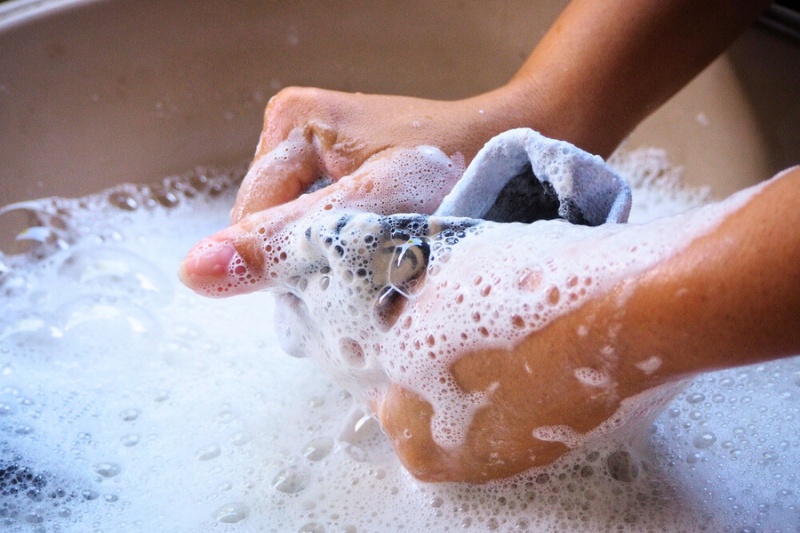
While technological innovations like Samsung’s Less Microfiber™ Filter aim to address microfibre release from machine washing, a lesser-explored dimension lies in the realm of hand-washing.
Recent research highlights a surprising revelation: hand-washing is not exempt from microfibre shedding.
Studies conducted by researchers from Keele University, Northumbria University, and Loughborough University, among others, looked at the impact of hand-washing on microfibre release. The findings were remarkable.
Hand-washing, often perceived as a more delicate method, led to significant microfibre shedding, ranging from 6,499 to 64,500 individual fibres per garment.
This shedding level was comparable to what is observed in machine-washing, challenging preconceived notions about the environmental friendliness of handwashing.
As the microfibre problem extends its reach to even the most seemingly “eco-friendly” laundry practices, it becomes imperative to rethink how we launder our clothes. So, what else can we do?
Factors That Affect Microfibre Release
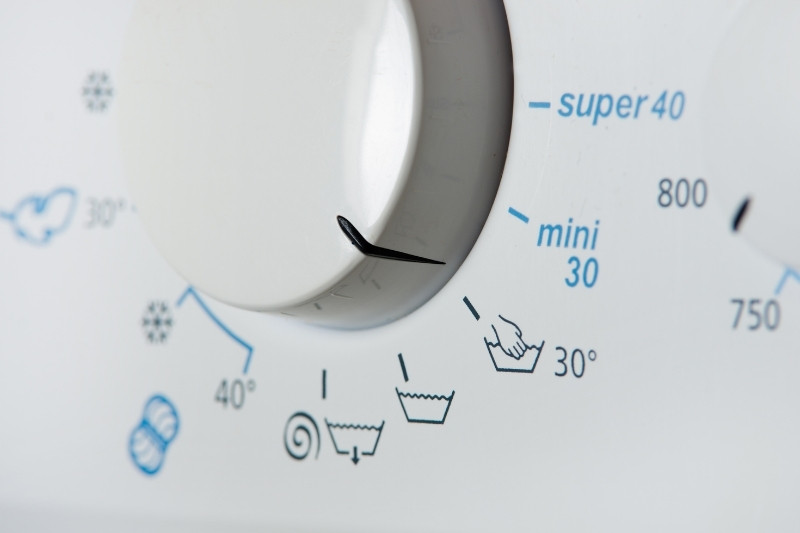
The launch of plastic-free laundry detergents and microfibre washing machine filters is certainly a step in the right direction, while handwashing isn’t as eco-friendly as it seems. But these points aside, are there other practices you can put into play to make your laundry routine more sustainable?
To answer these questions, we need to understand when microfibre release is at its highest. We found an interesting article in which Professor Judith Weis explains what contributes to microfibre release. Fabric type emerges as a key player, with loosely woven fabrics contributing more to microfibre shedding than tightly woven counterparts.
The research also uncovered that water temperature and detergent use contribute to the complexity of the microfibre problem. Professor Weis emphasises the impact of using cold water, which releases fewer microfibres than hot washes, and less detergent. The choice of washing machines even plays a role, with front-loading machines releasing fewer microfibres due to their tumbling action.
Practical Changes You Can Make
With these things in mind, you can make several sustainable changes to your laundry routine. The easiest to implement into traditional laundry practices is using cold water washes and washing full loads, which reduces the friction during the wash cycle and minimises microfibre release.
Additionally, using less detergent correlates with a decrease in microfibre release. However, you must also be intentional with your choice of detergent—opt for plant-based, eco-friendly, plastic-free options.
You can also choose to buy more clothes made from natural fibres such as cotton, wool and silk, and fewer made from synthetics such as polyester and acrylic. This will mean that the microfibres released in your laundry won’t contain as many microplastics.
When your washing machine packs in, consider switching from a top-loading to a front-loading design if you don’t have a front loader already to further combat microplastic release.
Innovative solutions like those we have mentioned have also emerged in the market, presenting alternatives to traditional washing practices. For example, external filters like Samsung’s offer a tangible solution, removing up to 98% of microfibers from rinse water.
Recognising the role of fabric texture in shedding rates can also inform choices towards more sustainable wardrobe selections.
Why Care About Making Laundry More Eco-Friendly?
There’s almost nowhere on earth that plastics haven’t been found, from the depths of the ocean to remote mountains.
The plastic pollution crisis hasn’t come from laundry alone—our world runs on plastic, which can be found in everything from bottles to carrier bags, skin-care products, and cigarette butts.
However, textiles are the largest known source of microplastic pollution in our oceans. As the world becomes increasingly aware of the plastic pollution crisis, adopting sustainable laundry practices becomes imperative.
But reducing microfibre emissions is not a singular endeavour—it’s a collective commitment to conscious consumption.
While new bills fighting for a greener future are being passed – like the recently proposed detergent ban in New York City — we can (and should) take control of our own laundry habits.
By implementing practical tips and embracing innovative solutions, you can contribute to a cleaner, healthier planet.

Hannah has a passion for cleaning. She worked her way around Australia by cleaning hostels in exchange for free accommodation and used her cleaning skills to bag a job as a chalet host for a luxury ski company in France.
